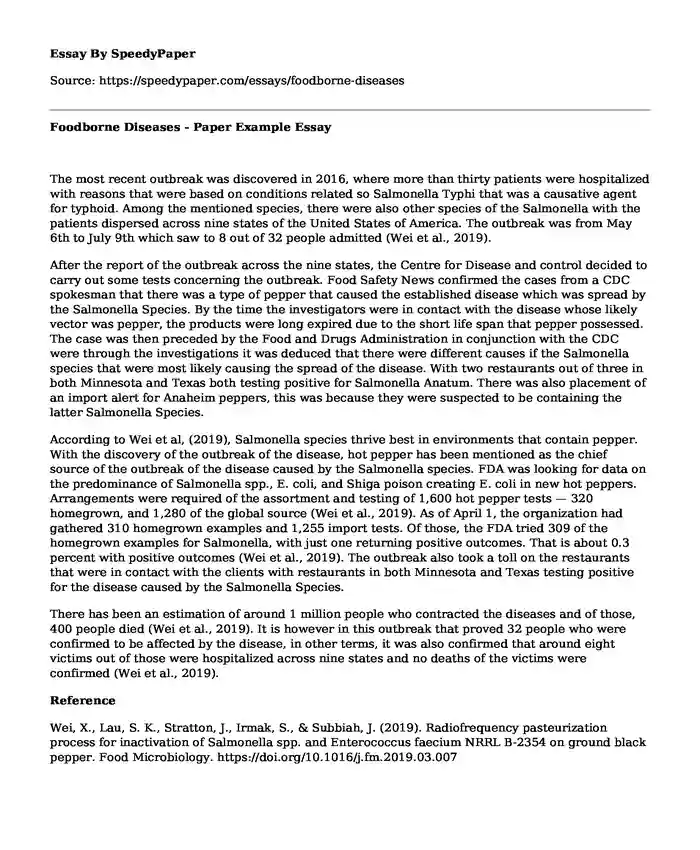
| Type of paper: | Essay |
| Categories: | Food Healthcare |
| Pages: | 2 |
| Wordcount: | 510 words |
The most recent outbreak was discovered in 2016, where more than thirty patients were hospitalized with reasons that were based on conditions related so Salmonella Typhi that was a causative agent for typhoid. Among the mentioned species, there were also other species of the Salmonella with the patients dispersed across nine states of the United States of America. The outbreak was from May 6th to July 9th which saw to 8 out of 32 people admitted (Wei et al., 2019).
After the report of the outbreak across the nine states, the Centre for Disease and control decided to carry out some tests concerning the outbreak. Food Safety News confirmed the cases from a CDC spokesman that there was a type of pepper that caused the established disease which was spread by the Salmonella Species. By the time the investigators were in contact with the disease whose likely vector was pepper, the products were long expired due to the short life span that pepper possessed. The case was then preceded by the Food and Drugs Administration in conjunction with the CDC were through the investigations it was deduced that there were different causes if the Salmonella species that were most likely causing the spread of the disease. With two restaurants out of three in both Minnesota and Texas both testing positive for Salmonella Anatum. There was also placement of an import alert for Anaheim peppers, this was because they were suspected to be containing the latter Salmonella Species.
According to Wei et al, (2019), Salmonella species thrive best in environments that contain pepper. With the discovery of the outbreak of the disease, hot pepper has been mentioned as the chief source of the outbreak of the disease caused by the Salmonella species. FDA was looking for data on the predominance of Salmonella spp., E. coli, and Shiga poison creating E. coli in new hot peppers. Arrangements were required of the assortment and testing of 1,600 hot pepper tests — 320 homegrown, and 1,280 of the global source (Wei et al., 2019). As of April 1, the organization had gathered 310 homegrown examples and 1,255 import tests. Of those, the FDA tried 309 of the homegrown examples for Salmonella, with just one returning positive outcomes. That is about 0.3 percent with positive outcomes (Wei et al., 2019). The outbreak also took a toll on the restaurants that were in contact with the clients with restaurants in both Minnesota and Texas testing positive for the disease caused by the Salmonella Species.
There has been an estimation of around 1 million people who contracted the diseases and of those, 400 people died (Wei et al., 2019). It is however in this outbreak that proved 32 people who were confirmed to be affected by the disease, in other terms, it was also confirmed that around eight victims out of those were hospitalized across nine states and no deaths of the victims were confirmed (Wei et al., 2019).
Reference
Wei, X., Lau, S. K., Stratton, J., Irmak, S., & Subbiah, J. (2019). Radiofrequency pasteurization process for inactivation of Salmonella spp. and Enterococcus faecium NRRL B-2354 on ground black pepper. Food Microbiology. https://doi.org/10.1016/j.fm.2019.03.007
Cite this page
Foodborne Diseases - Paper Example. (2023, Dec 30). Retrieved from https://speedypaper.net/essays/foodborne-diseases
Request Removal
If you are the original author of this essay and no longer wish to have it published on the SpeedyPaper website, please click below to request its removal:
- Essay Sample on Obesity among Children
- Free Essay Focusing on the Healthcare Barriers in Diverse Populations
- Free Paper with a Literature Review on Homelessness in Minnesota
- Paper Example: Professional Nursing and State-Level Regulations
- Free Essay. an Analysis of Medicare's Solvency Issues
- The Phenomenon of Interest; Advanced Directive - Free Essay
- Sugar in Kids Breakfast - Free Paper Sample
Popular categories




